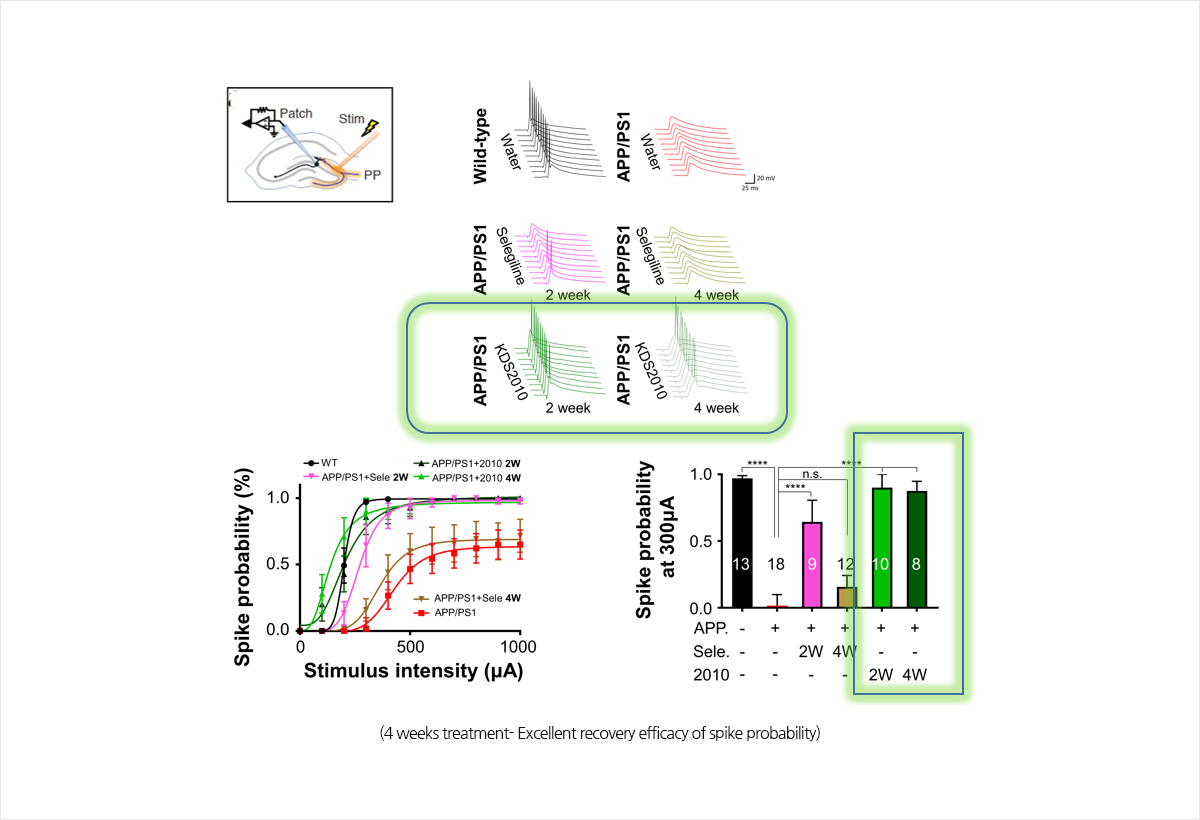Pipeline
NEUROBIOGEN has been working with an advisory network of researchers and clinical
experts specializing in brain & neurological diseases with long experience.
experts specializing in brain & neurological diseases with long experience.
Central nervous system disease
Central nervous system disease
- Alzheimer's dementia
- Stroke
AD functional mechanism by GABA Overproduction in reactive glial


Recovery efficacy of spike probability of KDS2010 in APP/PS1 mice


The new treatment mechanism of KDS2010 regulates abnormal excessive GABA production and release by effectively and selectively inhibiting MAO-B (monamine oxidase B) that is unduly occurred in reactive glial cells of Alzheimer's patients. This enables to fundamentally improve the neurodegeneration and cognitive impairment of Alzheimer's. This new mechanism, unlike β-amyloid pathway, facilitates the development of new drugs to cure cognitive dysfunction in Alzheimer's patients.
After feeding genetically modified mice with Alzheimer's on KDS2010 drug dissolved water, the Morris water maze and passive avoidance experiments were performed. As a result, it was confirmed that the mice's cognitive function was restored to normal levels and significantly improved even at a lower dose (1 mg/kg).
Especially in a comparative experiment with the existing comparator which has excellent initial efficacy in clinical but lacks that in prolonged treatment, KDS2010 maintained the neuronal firing, which is critical to cognitive performance, continuously for up to four weeks, whereas the control drug lost the ability 2 weeks later.
Furthermore, the result of its suitability as a drug (ADME/Tox) shows that KDS2010 is delivered into the human brain with very high potency and has excellent drug properties without adverse effects on other nervous systems.
Especially in a comparative experiment with the existing comparator which has excellent initial efficacy in clinical but lacks that in prolonged treatment, KDS2010 maintained the neuronal firing, which is critical to cognitive performance, continuously for up to four weeks, whereas the control drug lost the ability 2 weeks later.
Furthermore, the result of its suitability as a drug (ADME/Tox) shows that KDS2010 is delivered into the human brain with very high potency and has excellent drug properties without adverse effects on other nervous systems.
This study shows that KDS2010 passes through the BBB(Blood-Brain-Barrier) and is delivered to the brain with high efficiency and excellent health safety, so we can expect worthy results in long-term clinical trials for dementia medications. This is to identify the cause of failure of existing drugs that have not been approved even though they have shown short-term efficacy in past, as well as to raise expectations that their limitations can be overcome.


As a result of confirming the recovery effect of motor function by single-pellet reaching test and cylinder test, the sophisticated motor function was restored to near normal level when KDS2010 drug administration and rehabilitation training were combined.
In addition, cylinder test has shown that motor function recovery of the stroke rodent model is significantly impaired, while that of drug administration groups (Stroke+KDS2010) is significantly recovered compared to the control.
In the case of drug administration (Stroke+KDS2010), the infarct size was reduced compared to the control. Especially, in the experiment group (Stroke+rehab+KDS2010) which was combined with drug administration and rehabilitation, the size within internal capsules was significantly reduced.
Consequently this confirms that KDS2010 can restore motor function, and prevent and treat stroke by reducing the infarct area.
In addition, cylinder test has shown that motor function recovery of the stroke rodent model is significantly impaired, while that of drug administration groups (Stroke+KDS2010) is significantly recovered compared to the control.
In the case of drug administration (Stroke+KDS2010), the infarct size was reduced compared to the control. Especially, in the experiment group (Stroke+rehab+KDS2010) which was combined with drug administration and rehabilitation, the size within internal capsules was significantly reduced.
Consequently this confirms that KDS2010 can restore motor function, and prevent and treat stroke by reducing the infarct area.

